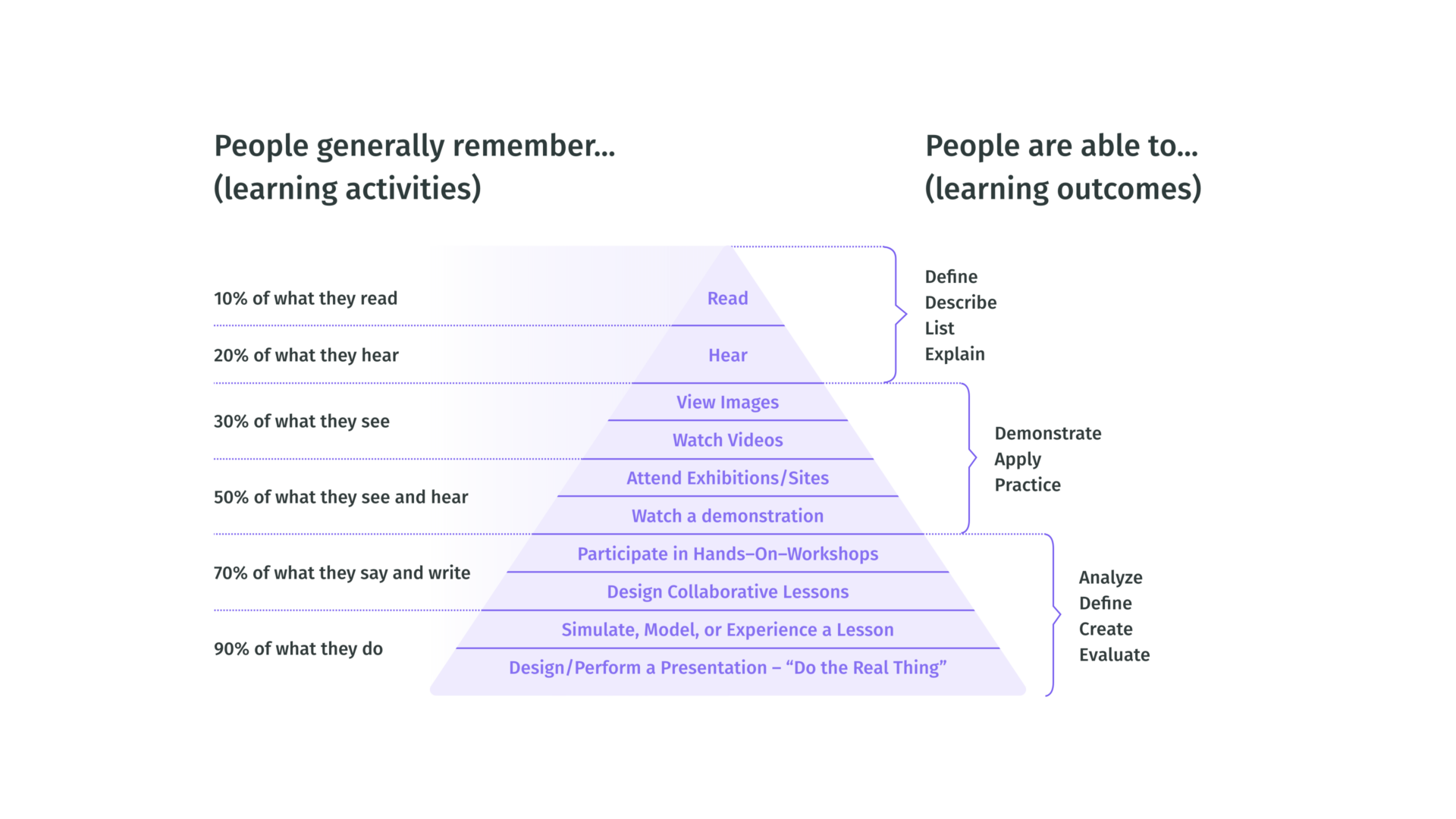Blended learning and how you too can apply it
Blog / News | 30-03-22
Anyone who is still involved with learning – whether it’s because you’re a student yourself, you work in the education sector, or you get involved in corporate learning – has heard of blended learning. Why is there so much advocacy for this? How complicated is it? And how can you apply it in the best way possible? We discuss that here.
Pyramid points
Blended learning is about combining different forms of learning, especially online and offline, and connecting them seamlessly. The success of blended learning can be explained using the ‘Learning Pyramid’ (see image). This pyramid describes a number of learning methods, such as reading, watching videos, listening to lectures, and attending a workshop. According to the model, the more “effort” a person has to put into learning, the more they remember. Listening is more passive than a workshop, and giving a presentation on a topic is a lot more intense than just reading the book. The more active the method, the more ‘points’ you pick up on the pyramid.

Less More is more
It actually sounds quite simple: replace all classroom training and lectures with workshops and you’re there! Unfortunately, you don’t get away with it that easily. Research shows that remembering and reproducing information is easier when the ways in which the information is conveyed are alternated. The brain then creates more connections, so the information is better remembered. In an ideal situation, you don’t just do a workshop, but you also offer reading material, a video, then a workshop, and after a discussion with other students. Fantastic, but probably unrealistic in terms of time and finances. How do you make blended learning a little more feasible?
Try to add as much variety as possible within the limits of what is possible. We’ll make a few suggestions:
- Audio-visual works. Audio appeals to a different part of the brain than something visual. As a result, looking at something while listening is more effective than addressing only the visual part in your brain. Try to combine both to get more out of your workouts.
- Elements should reinforce each other. Adding an image to a text is the simplest example of adding variety to your learning content. It may seem simple, but it already makes the learning effect better than if you only present people with text. But … An image placed only to brighten things up can be a distraction, so make sure it is something useful and relevant. Have you ever gotten better from someone reading a boring presentation directly from the slides? Chances are the answer is ‘no’, so mix it up!
- Put people to work. You can make this as complicated as you like. From an online workshop to a complete real-life simulation. It can be as simple as asking for a summary after a classroom training, or make notebooks and pens available during training and forego laptops and phones. If people write along instead of typing, they have to reduce the information to the core ideas during the training. You may be able to keep up with the pace while typing, but nobody writes as fast as someone talks. While writing, someone has to actually listen and immediately distill the most relevant information.
- Ask questions. Also think about assessment-based learning. Don’t just have students read passively, but have them think about the material through questions. This increases the pressure to think carefully, to apply the material immediately and to learn directly from the right or wrong answers. If you also have several question variations about the information to be learned (a knowledge element), that also adds to the learning effect.
- A discussion works wonders. You can make it so that it doesn’t even take that much effort. If you get a number of people together (even if it is via Zoom), and prepare a few questions or propositions, you are already there. Get course participants to talk to each other about what they’ve learned recently, or maybe even before they start a course.
These are just a few simple examples. There are, of course, countless other ways to apply blended learning. But it is certain: blended learning works. Variation is the key, as long as everything you include really adds value. Try to include online and offline elements in particular, such as a combination of e-learning and real-life discussion. Alternate different methods as much as possible to get the best return.
Drillster and blended learning
How does Drillster fit into a blended learning course? Drillster can be used in all phases of a course or study. Prior to a physical meeting, in order to achieve a certain level of knowledge. During a course, to get students to actively work with the material and to use the results in class (flip the classroom). And after the course for retention and knowledge anchoring.
